In today’s fast-paced business environment, contact centers play a critical role in ensuring customer satisfaction and loyalty. For contact center managers, improving agent performance metrics is a top priority. Contact center agent metrics can include key performance indicators (KPIs) such as response time, customer satisfaction, and first-call resolution rates.
Using artificial intelligence (AI) to improve these metrics can be a game-changer for contact centers hoping to reduce expenses and scale support capabilities. In fact, nearly 90% of contact centers have plans to invest in advanced AI. In this blog post, we’ll explore how AI can significantly enhance contact center agent metrics for faster, more efficient support.
Understanding Contact Center Agent Metrics
Before diving into how AI can help, it’s essential to understand the key metrics that gauge agent performance:
- Response Time: The time taken by an agent to respond to a customer query.
- First Call Resolution (FCR): The percentage of customer issues resolved during the first interaction.
- Average Handle Time (AHT): The average duration an agent spends on a call, including hold time and after-call work.
- Customer Satisfaction (CSAT): A measure of how satisfied customers are with the service provided.
- Agent Utilization: The percentage of time agents spend actively working vs. idle time.
AI-Powered Deflection: Reducing Agent Workload
AI-powered deflection is the process of using AI to handle simple and repetitive tasks, thereby freeing up human agents to focus on more complex issues. Here’s how it works:
Chatbots and Virtual Assistants
AI chatbots and virtual assistants can manage high volumes of routine customer inquiries. By handling tasks like password resets, order status checks, and basic troubleshooting, these AI tools significantly reduce the workload on human agents.
Why It Matters:
- Lower Costs: The average cost of per customer service call is between $2.70 and $5.60. By using AI to address low-level issues before they escalate into a call, contact centers can save money on support costs.
- Efficiency: AI chatbots can handle multiple inquiries simultaneously, ensuring customers get instant responses without waiting in a queue.
- Improved Metrics: By deflecting routine tasks, agents can focus on resolving complex issues, thereby improving metrics like FCR and CSAT.
Intelligent Routing
AI systems can intelligently route customer inquiries to the most suitable agent based on various factors such as agent specialization, customer history, and the nature of the query. This ensures that customers are connected to the right agent who can resolve their issues efficiently and quickly.
Why It Matters:
- First Call Resolution: Proper routing ensures that issues are resolved in the first interaction.
- Reduced Handle Time: Agents are more efficient when handling queries they are best suited for, reducing AHT and improving overall service quality.
Enhancing Response Time with AI
Response time is a crucial metric in determining customer satisfaction. Faster response times generally lead to happier customers. Here’s how AI helps improve this critical metric:
Real-Time Assistance
AI can provide real-time assistance to agents during customer interactions. Advanced AI systems can transcribe and analyze live conversations to offer relevant suggestions, knowledge base articles, and action prompts to agents.
Why It Matters:
- Faster Resolutions: Agents can quickly access the information they need without having to search manually.
- Improved Accuracy: AI ensures that the information provided to customers is accurate and relevant.
Automated Follow-Ups
AI-powered systems can automate follow-up actions such as sending confirmation emails, updating customer records, and scheduling callbacks. This reduces the after-call workload for agents, allowing them to move on to the next customer more quickly.
Why It Matters:
- Reduced Idle Time: Automated follow-ups minimize after-call work, reducing overall response and handle times.
- Enhanced Productivity: Agents can handle more queries in less time, improving utilization rates.
AI and Performance Metrics
AI not only helps in deflecting routine tasks and speeding up response times but also provides valuable insights into agent performance. Here’s how AI-driven analytics can improve contact center agent metrics:
Call Progress Analysis
AI can determine whether a voicemail machine or a human has been reached in a call, helping to optimize agent utilization and reduce idle time.
Why It Matters:
- Customer Satisfaction: Understanding sentiment allows agents to adjust their approach, improving CSAT scores.
- Actionable Insights: Managers can use sentiment data to identify areas for agent improvement and training.
Predictive Analytics
AI systems can predict future call volumes, potential customer issues, and agent performance trends. This allows contact center managers to plan better and allocate resources more effectively.
Why It Matters:
- Proactive Management: Predictive insights help in taking proactive measures to address potential issues.
- Resource Optimization: Efficient resource allocation ensures agents are not overburdened, maintaining high performance and morale.
Personalized Training and Development
AI-driven analytics can identify specific areas where individual agents need improvement. Based on this data, personalized training programs can be designed to address these gaps.
Why It Matters:
- Targeted Training: Personalized training ensures that agents receive the support they need to improve specific metrics.
- Continuous Improvement: Regular, data-driven training keeps agents updated with best practices, improving overall performance.
Real-Time Monitoring and Feedback
AI provides real-time monitoring capabilities, allowing managers to oversee agent performance as it happens. This enables immediate feedback and coaching.
Why It Matters:
- Instant Corrections: Real-time feedback allows agents to adjust their approach on the spot, improving metrics like AHT and FCR.
- Ongoing Support: Continuous monitoring and feedback create an environment of ongoing support and development.
The Role of AI in Improving Customer Experience
Beyond improving agent metrics, AI plays a significant role in enhancing the overall customer experience. By ensuring quicker responses, accurate information, and efficient resolutions, AI contributes to higher customer satisfaction and loyalty.
Why It Matters:
- Better Bottom Line: Improving CX can improve sales revenue by 2 to 7%, and overall profitability by 1 to 2%.
- Customer Loyalty: A superior customer experience leads to increased customer loyalty and repeat business.
- Brand Reputation: High levels of customer satisfaction enhance your brand’s reputation, attracting new customers.
Final Thoughts
Incorporating AI into your contact center operations is more than just a trend; it’s a strategic move that can drastically improve your contact center agent metrics. From AI-powered deflection and intelligent routing to real-time assistance and backend automation, AI offers numerous ways to enhance agent performance and operational efficiency.
By focusing on improving metrics like response time, first call resolution, and customer satisfaction, AI ensures that your contact center not only meets but exceeds customer expectations. This leads to higher levels of customer loyalty, better agent morale, and ultimately, greater business success.
Embrace the power of AI to transform your contact center and take your agent metrics to the next level. Your agents will be more productive, your customers will be happier, and your business will thrive.
Ready to revolutionize your contact center agent metrics with AI?





